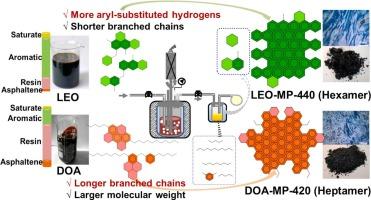重质石油馏分合成高各向异性中间相沥青
IF 5.9
3区 工程技术
Q1 CHEMISTRY, MULTIDISCIPLINARY
Journal of Industrial and Engineering Chemistry
Pub Date : 2025-05-16
DOI:10.1016/j.jiec.2025.05.018
引用次数: 0
摘要
芳香族化合物和树脂是重质石油馏分的关键成分,影响着热缩合合成中间相沥青(MP)。本研究探讨了两种不同原料的MP形成:一种是富含芳香的润滑油萃取油(LEO),另一种是富含树脂的沥青(DOA)。尽管它们的成分不同,但两种原料的各向异性含量都接近100%。含有79%芳香族化合物的LEO产生的MP具有广域流线型纹理,而含有62%树脂的DOA产生的MP具有马赛克纹理。这些结构上的差异是由于两种原料的不同组成。基于FTIR、MALDI-TOF-MS和NMR分析,采用改进的Brown-Ladner方法构建了平均分子结构模型。结果表明,与DOA相比,LEO含有更多的芳烃,分子尺寸更小,支链更短,亚甲基桥结构更丰富。芳香族低聚反应是热缩聚过程中发生的主要反应。分子结构的变化导致所得MP性质的显著差异。从LEO合成的MP主要由有序六聚体组成,而从DOA合成的MP主要由无序七聚体组成。最后,提出了芳香族化合物的寡聚化机制,为高质量MP生产的原料选择提供了见解。本文章由计算机程序翻译,如有差异,请以英文原文为准。

Synthesis of mesophase pitch with high anisotropic content from heavy petroleum fractions
Aromatic compounds and resins are key constituents of heavy petroleum fractions, influencing the synthesis of mesophase pitch (MP) via thermal condensation. This study explores MP formation from two distinct feedstocks: an aromatic-rich lubricant extraction oil (LEO) and a resin-rich deoiled asphalt (DOA). Despite their compositional differences, both feedstocks produced nearly 100% anisotropic content. LEO, containing 79% aromatic compounds, generated MP with a wide-area, streamlined texture, while DOA, with 62% resin, resulted in a mosaic texture. These textural differences are attributed to the distinct compositions of the two feedstocks. Average molecular structure models were constructed using the improved Brown-Ladner method, based on FTIR, MALDI-TOF-MS, and NMR analyses. The models indicate that LEO contains more aromatics, smaller molecular size, shorter branched chains, and richer methylene-bridged structures than DOA. Aromatic oligomerization is the primary reaction occurring during thermal condensation. Variations in molecular structure lead to significant differences in the properties of the resulting MP. MP synthesized from LEO was dominated by ordered hexamers, while MP from DOA was predominantly composed of disordered heptamers. Finally, an oligomerization mechanism for aromatic compounds is proposed, providing insights into the selection of raw materials for high-quality MP production.
求助全文
通过发布文献求助,成功后即可免费获取论文全文。
去求助
来源期刊
CiteScore
10.40
自引率
6.60%
发文量
639
审稿时长
29 days
期刊介绍:
Journal of Industrial and Engineering Chemistry is published monthly in English by the Korean Society of Industrial and Engineering Chemistry. JIEC brings together multidisciplinary interests in one journal and is to disseminate information on all aspects of research and development in industrial and engineering chemistry. Contributions in the form of research articles, short communications, notes and reviews are considered for publication. The editors welcome original contributions that have not been and are not to be published elsewhere. Instruction to authors and a manuscript submissions form are printed at the end of each issue. Bulk reprints of individual articles can be ordered. This publication is partially supported by Korea Research Foundation and the Korean Federation of Science and Technology Societies.

 求助内容:
求助内容: 应助结果提醒方式:
应助结果提醒方式:


